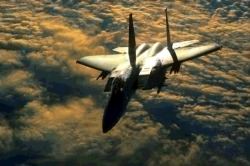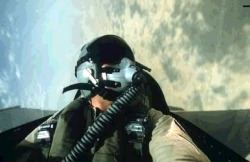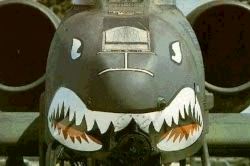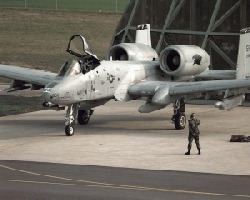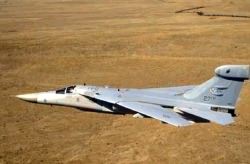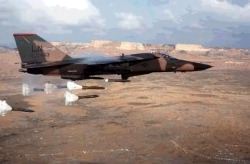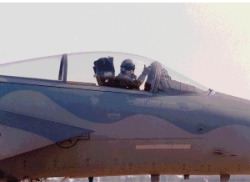| Book Review: "Gulf Air War Debrief," Ed. Stan Morse
by Scott Purdy |
||||
|
We carry around a bewildering array of images from Desert Storm: CNN correspondents conducting interviews in aardvark-snooted gas masks, burning oilwells like something out of Dante's imagination, ghost-green target pod footage of LGBs whisking through air vents into bunkers of vague strategic value. But to understand the events of that war - particularly the diverse forms of air combat that took place - we need something more than old videotapes of Wolf Blitzer coolly explaining the mayhem, the mayhem, via satellite. Fortunately there is Gulf Air War Debrief, from the writers of World Air Power Journal, to address our interest. With all the technical-savvy of a fine simulation, this volume illuminates in staggering detail the exploits and systems of every coalition aircraft that took part in the war. On one page alone you're likely to find a gorgeous color 3-view of a desert-scheme SEPECAT Jaguar, pilot accounts of its mission, and incredibly small text explaining such esoterica as its 'wedge' nose, or why those AIM-9Ls are mounted on top of the wings. Turn the page and you get another 3-round burst of awesome photography that makes most everything from World Air Power such a joy to behold. Flipping through the book one finds first-person accounts of the pilots of A-6 Intruders, Tornadoes, Sparkvarks, even OV-10 Broncos. All those aircraft whose participation in the war we vaguely recall - embedded somewhere in our gray matter - finally come to light when you begin to read detailed debriefs of the role each aircraft played in that symphony of destruction. Keep in mind also the diversity of weapons used in Desert Storm, unfolding as it did on the twilight of the Cold War. There were aging beasts like the F-4 and A-7, veterans of previous conflicts, suddenly fighting alongside the F-15E and F-117 - at that time still virtually unproven in combat. This book dedicates at least several pages to each of those aircraft. For most every participant there are explanations of its mission, a number of action-photographs, and a requisite assortment of racy nose art thrown in for good measure. Of further interest to flight-simmers are the detailed maps of, for instance, Iraq's air bases, perfect for enhancing your mission design in F-15. Besides showing us how to set up a proper Hornet SEAD package ("HARM missiles zoom to high altitude after launch, which is why HARM shooters often flew above and behind the main strike package") there are diagrams illustrating such things as the F-111F's bombing profile using its Pave Tack pod. One of my favorite parts of the book is the narrative of Lt. Devon Jones, an F-14 pilot who was shot down very deep in Iraq by an SA-2. Following his ejection, Jones was tracked down by a pair of A-10 'Sandies', like the Douglas Skyraiders in Vietnam trained in combat SAR. "They asked me to shine my signal mirror south, which I did, but they didn't see it. Then one of the A-10s told me to start looking for a helo about 15 miles out. As I looked south at the standard helo altitudes - maybe 500 feet - I couldn't see them. But I did get a tally on the A-10s flying in a circle. I talked them in. "I had made a mistake earlier when I first contacted the 'Sandies'. They asked me where I was relative to my plane's crash site. " 'About eight to ten miles north,' I replied. 'About a thousand yards due east of a blue [water] tank.' The Iraqis must have been listening to our transmissions, and, of course, they must have known where the tank was.
"As the planes came in, everything seemed to be heading to a big crescendo. About half a mile down the south road, I spotted a truck, an army truck, with the canvas covers - a grunt truck. I think we all saw it at the same time because the A-10 called, 'We've got a fast mover on the dirt road.' This guy was boresighting right at me, down in my hiding place. I saw a lot of dust and I thought I had actually seen two trucks . . . . "Within three to four seconds, the 'Sandies' set up a squirrel cage and rolled in on the truck, maybe 100 ft AGL, 200 ft slant range. They opened up with their 30-mike-mike. By the time they each finished two runs there was nothing out there, just flames and dust, about 100 yd from me. I guess the Iraqis had finally figured out where I was through all our radio talk." Warthoggers reading the book can then turn to the heady A-10 reference section for further details of that plane's exploits and massive armament. On one day alone 23 tank kills were recorded by Eric Solomonson and John Marks. "The A-10A pilots, carrying infrared AGM-65 Maverick missiles and 30-mm ammunition (1,174 rounds), swooped through the haze and attacked the tanks. The Maverick missiles, which detect and home on heat sources, had unusually rich targets with the tank engines running and extremely hot. It took ten minutes for the pair to kill six tanks with Mavericks.
|
"Two more fell beneath the driving force of the A-10's 30-mm GAU-8/A seven-barrelled cannon. The gun is the most powerful (in terms of muzzle velocity) ever mounted in an aircraft, firing uranium-depleted rounds the size of a milk bottle, which can penetrate the steel hull of a tank, or even the 'reactive armor' employed by some Soviet tanks, at distances up to 7,000 yd…"
Because Gulf Air War Debrief is so comprehensive in scope, one gets a flavor for the less glamorous (but no less important) aircraft as well. There are subsections in the book devoted to such topics as Defense Suppression, Electronic Intelligence (ELINT aircraft, like the RC-135 Rivet Joint), or Marine Close Air Support. The latter includes, for example, a detailed diagram of the AV-8B Harrier II making a 45 degree dive attack and popping flares as it enters the lethal defense zone. Then there are further analyses of the AH-1W Super Cobra with a glorious color 3-view in its disruptive desert scheme.
By now you're getting the idea that this reference work is huge, a full 232 encyclopedic pages. Even after having owned the book for several months you're not likely to open it without unearthing some new factoid. Toward the back of the book is a fascinating compendium of all the ground and air munitions used during the war, including blueprint illustrations of each weapon. JP-233 dispensers, CBU-89/B Gator mines, Mk 77 Napalm bombs are all represented here, among others. Above these are an extensive list of customary loadouts for each aircraft, depending on its mission. About the F-15E (who knew this?): "For ['Scud' hunting duties], a two-ship formation would be launched. The leader carried four GBU-10C/Bs mounted on the front and rear 'bottom' CFT pylons, two 600 gal fuel tanks as well as AIM-9L/Ms on the wing pylons, an empty centerline pylon and both types of LANTIRN pods. The wingman was configured similarly, but without the targetting pod, and carried either six CBU-87/B CEM or 12 Mk 82 LDGP bombs." Handy stuff for mission planning, eh?
For those of you who love building missions in sims like F-15, this book may prove useful. Besides containing loads of ideas for missions, you begin to see more accurately the roles of different aircraft. F-4Gs ought to rendezvous with you coming from the east during ingress, since they were deployed at the southern airfield in Bahrain. At Al Kharj you can put down a few F-15Cs and F-16s since they shared the base. (Assuming that kind of accuracy is important to you. I eat this stuff for breakfast.) Of course the book would be incomplete without stories of air-to-air combat, and descriptions of these missions abound, usually from the vantage of the pilots. There's a fine story of four F-15Cs that engaged a 3-ship flight of MiG-23 Floggers trying to flee to Iran, along with that now famous account of the Hornets that shot down a pair of MiGs and then continued on to strike their mud target. "The MiG[-21]s approached us, nose on, supersonic at Mach 1.2. Our relative rate of closure was more than 1,200 kt. They weren't maneuvering . . . . I shot a Sidewinder first. It was a smokeless missile and I thought, at first, that I had wasted it because I couldn't see it tracking toward the MiG. I fired a Sparrow. The first missile actually did the job, and the Sparrow flew into the fireball. The whole event, from the E-2s call to missile impact, took less than 40 seconds…. "This was the first time to my knowledge that an airplane scored a kill while carrying four 2,000-lb bombs, then continued on to hit its target. If the MiGs had got behind us, we would have had to honor their threat. You can't do that with 8,000 lb of bombs. We would have had to jettison our ordnance to face them, and that would have served their purpose in stopping our strike. They failed; we succeeded."
At 30 bucks the book isn't cheap, but having had Gulf Air War Debrief for several months now, I still find myself fascinated by it and consider the book a more than worthy investment. I can say with some confidence that for fans of Falcon 4.0 and F-15 the book is an excellent reference tool and one of those 'must-haves' for any combat library. Download a custom mission for F-15 using details from Gulf Air War Debrief. Download Fallujah Attack. All photos courtesy U.S. Air Force.
|
|||
|
© 1997 - 2000 COMBATSIM.COM, INC. All Rights Reserved. Last Updated January 26th, 1999 |
||||

